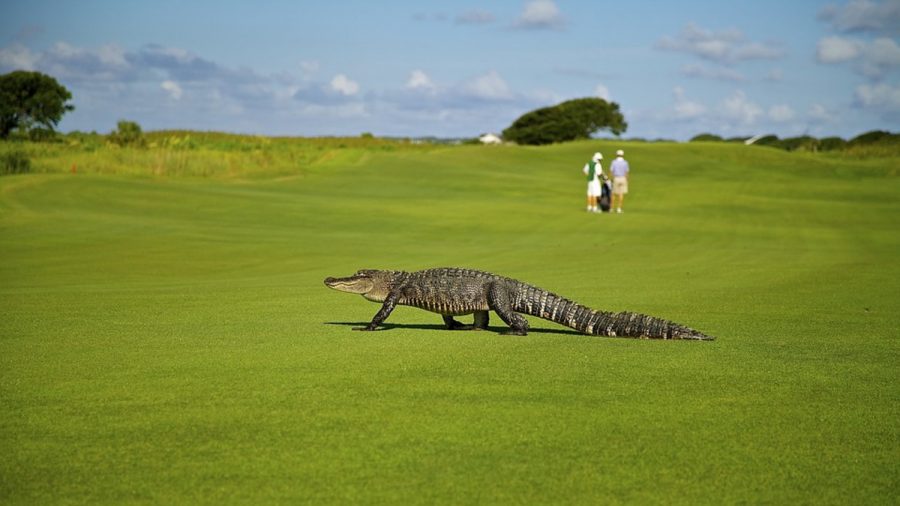Officers at the Jupiter Police Department removed a 750-pound alligator from a local park in Jupiter, Florida, on March 28.
Responding to an alligator call the officers removed the 12 feet long reptile from the Commerce Park area. The department shared their adventure in a Facebook post.
“He was carefully removed without harm from the area and relocated to a safe place,” police said in the post.
This morning officers responded to an alligator call in the Jupiter Commerce Park area. This gator was almost 12 feet…
Posted by The Jupiter Police Department on Thursday, March 28, 2019
Another 12-foot, a 500-pound alligator was caught in Parrish, Florida, lurking in the water in December last year.
The gator was captured on Dec. 19, as it was “menacing” divers who were working on a private project on the waterway, according to WKMG-TV.
Divers discovered the massive gator underwater and immediately got out to request help, according to Jim Cutway, a licensed alligator trapper who helped in the capture of the alligator.
“The divers had less than 5 feet of visibility, and they knew he was there,” he told WKMG-TV. “The gator was very close [to] them. He was bothering them.”
Half an hour later, a trapper from the Florida Fish and Wildlife Conservation Commission came to help Cutway capture the beast.
“The divers said, ‘We’re out of here until something is done with him,’” Cutway said.
To coax the gator from the water, Cutway said he and the other trapper used calls until the gator “popped” his head out of the water.
Upon seeing the huge alligator Cutway’s first reaction was “Wow!”

It took more than two hours for them to wrangle the gator out of the water and onto the shore. While they weren’t in any immediate danger, the gator did give them a “long-fought tug of war,” Cutway said, adding, “That one was very girthy, big bull gator.”
Eventually, the large gator was taken to an alligator farm on the state’s east coast, the WKMG-TV reported.
As soon as the gator was gone, the divers returned to their underwater project, according to Cutway.
Alligators versus Crocodiles
The American alligator is much smaller than the Nile crocodile, usually topping out at 15 feet. While that may already sound massive, the biggest Nile crocodiles can be longer than a giraffe is tall, according to the National Geographic.
While average size Nile crocs weigh around 500 pounds, like the American alligator captured in Florida, large ones can weigh up to 1,650 pounds.
Head Shape
Another difference is the shape of the head.
Alligators have broader, U-shaped rounder heads, while crocodiles have more triangular, V-shaped, longer and narrower skulls.
However, as with most things in life, there are exceptions to the rules.
Mugger crocodiles, Crocodilis palustris, have a broad snout like an alligator.

Teeth
Teeth, too, are a point of difference.
All crocodiles have special glands in their tongues that can get rid of excess salt, so they tend to be found in saltwater habitats, such as mangrove swamps and estuaries. Alligators, on the other hand, do not have these glands, so they prefer to live in freshwater habitats.
However, saltwater crocodiles are at home in both freshwater and saltwater habitats, and often swim along coastlines.
Teeth
Teeth are also a point of difference.
For crocodiles, the fourth tooth on the lower jaw sticks up over the upper lip, making it visible when the mouth is closed. On alligators, this fourth tooth is covered up.
Offspring
Nile crocodiles also have fewer offspring than American alligators, according to Abby Lawson, a doctoral candidate in the Department of Forestry and Environmental Conservation at Clemson University.
Aggressiveness
Additionally, “Nile crocodiles are generally considered to be much more aggressive than American alligators or American crocodiles,” said Adam Rosenblatt, an expert on crocodiles and a postdoctoral associate at the Yale School of Forestry and Environmental Sciences.
With its man-eater reputation, the Nile crocodile can reach 20 feet in length and take down everything from hippos to humans, the National Geographic reported.
Nile crocodiles aren’t picky eaters, although their primary diet consists of fish. Their indiscriminate diet means they’ll happily take a chomp out of whatever or whoever crosses their path, from zebras, porcupines, humans, and even other crocodiles. At every feeding time, a Nile crocodile can eat up to half its weight.
While American alligators and crocodiles account for 33 human fatalities since 2000, the Nile crocodile has killed 268 people in the same time span, according to National Geographic.
Because of its vicious reputation, the Nile crocodile was hunted close to extinction in the 1940s through the 1960s, according to the National Geographic. Since then, local and international protections have helped them rebound in most areas.
However, in some regions, pollution, hunting, and habitat loss have severely depleted their numbers.
Actually, the Nile crocodile is not the largest crocodilian.
The largest is a saltwater crocodile known as Crocodylus porosus and can reach 23 feet and weigh up to 2,600 pounds.
That makes for some monstrous crocodiles.
Epoch Times reporter Tiffany Meier contributed to this report.
From The Epoch Times


